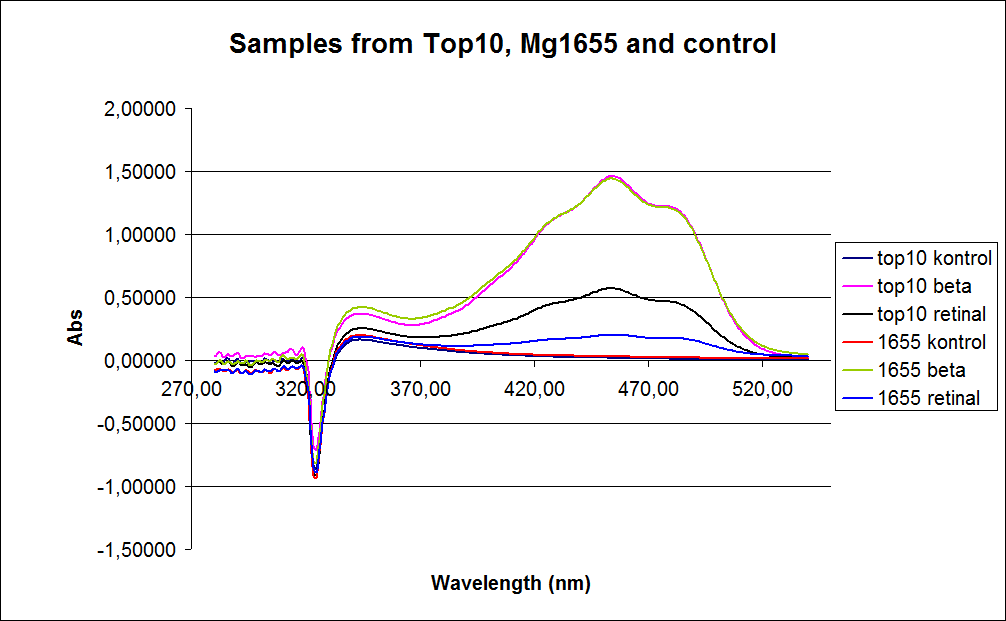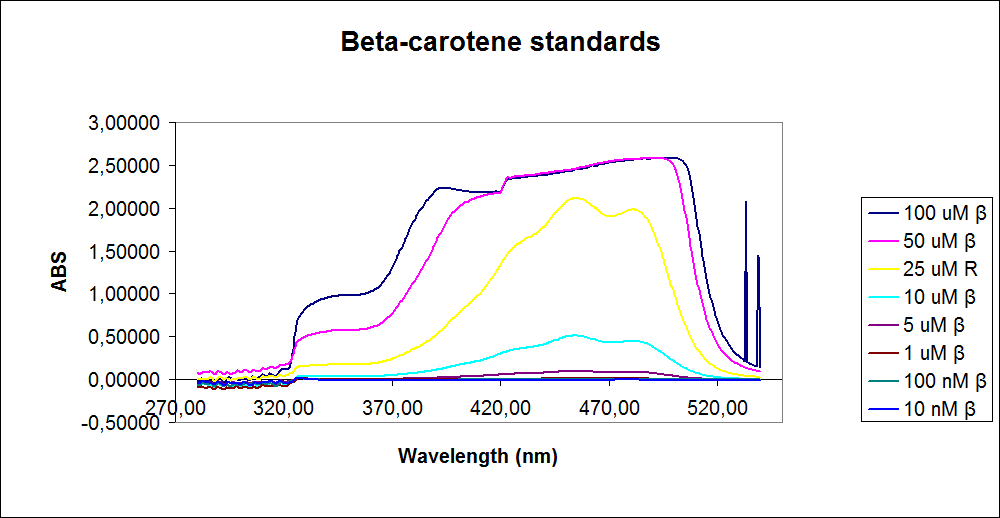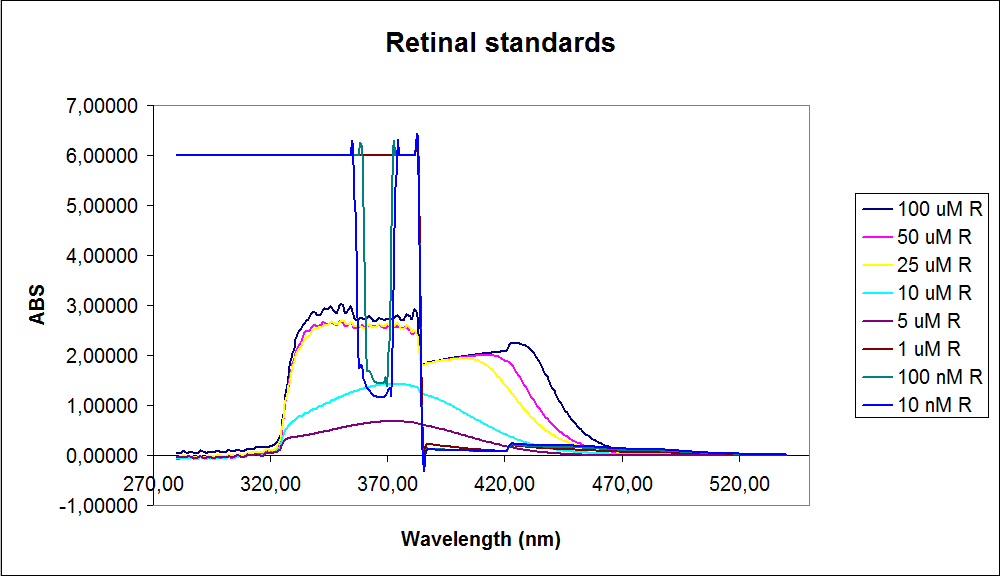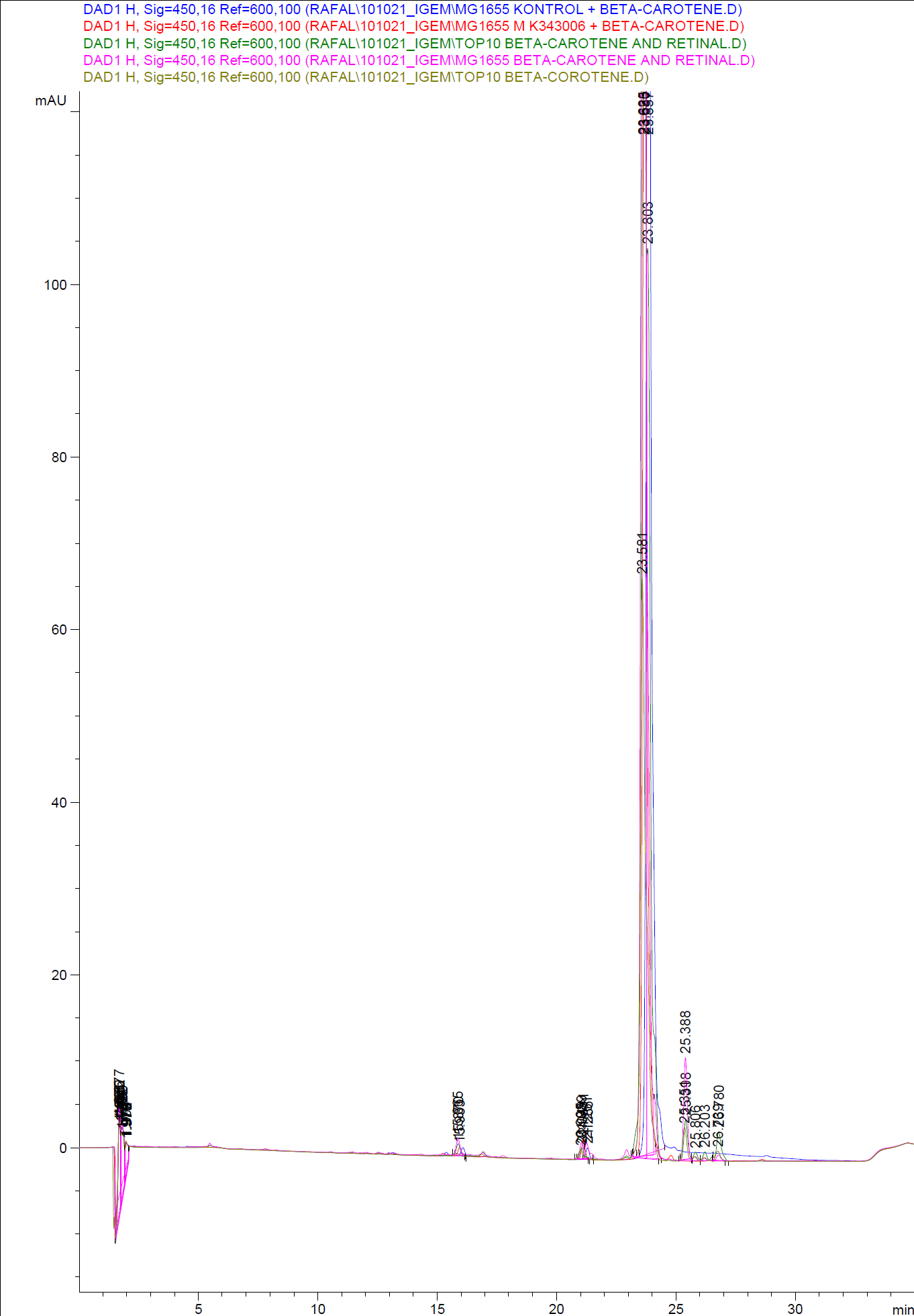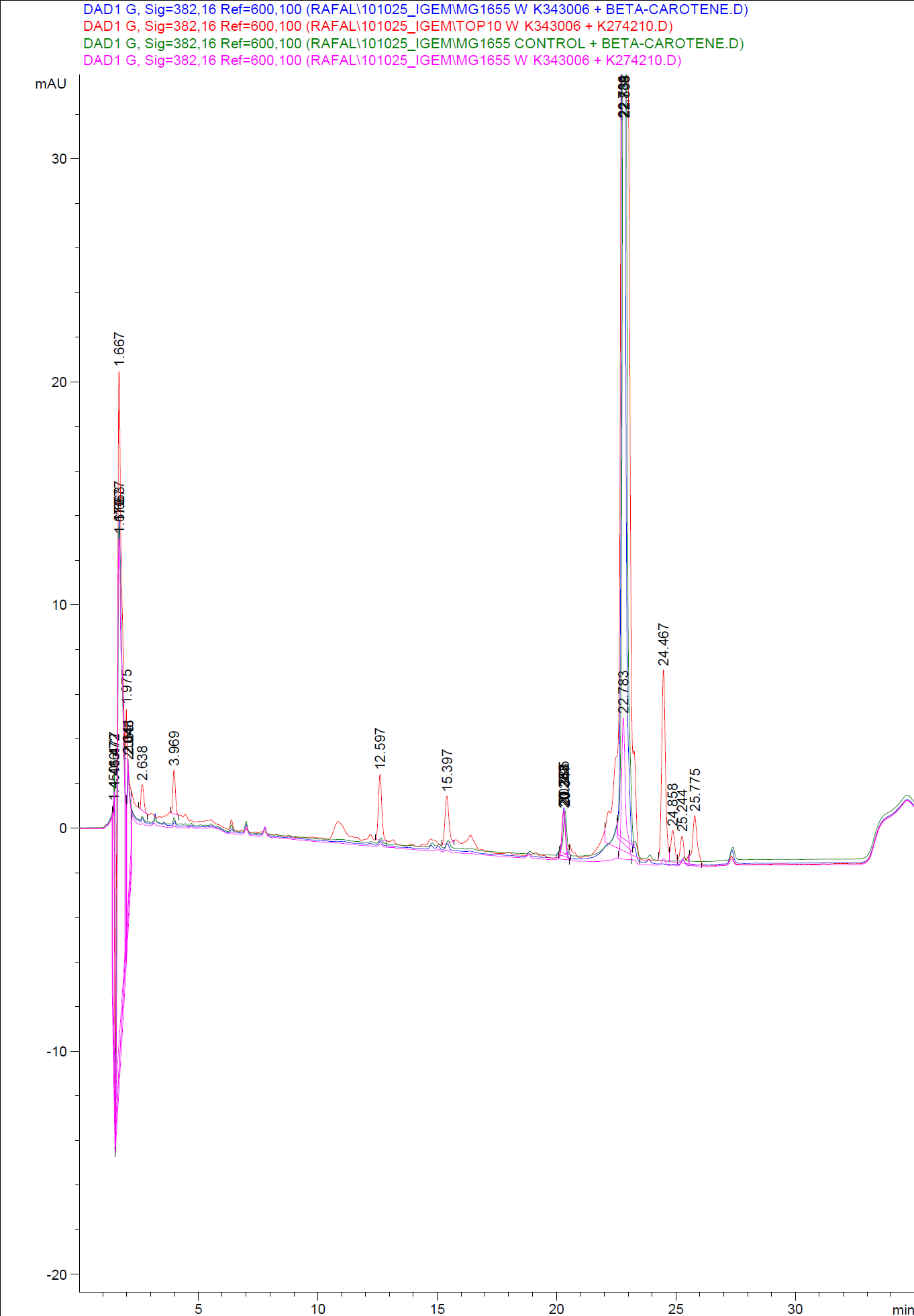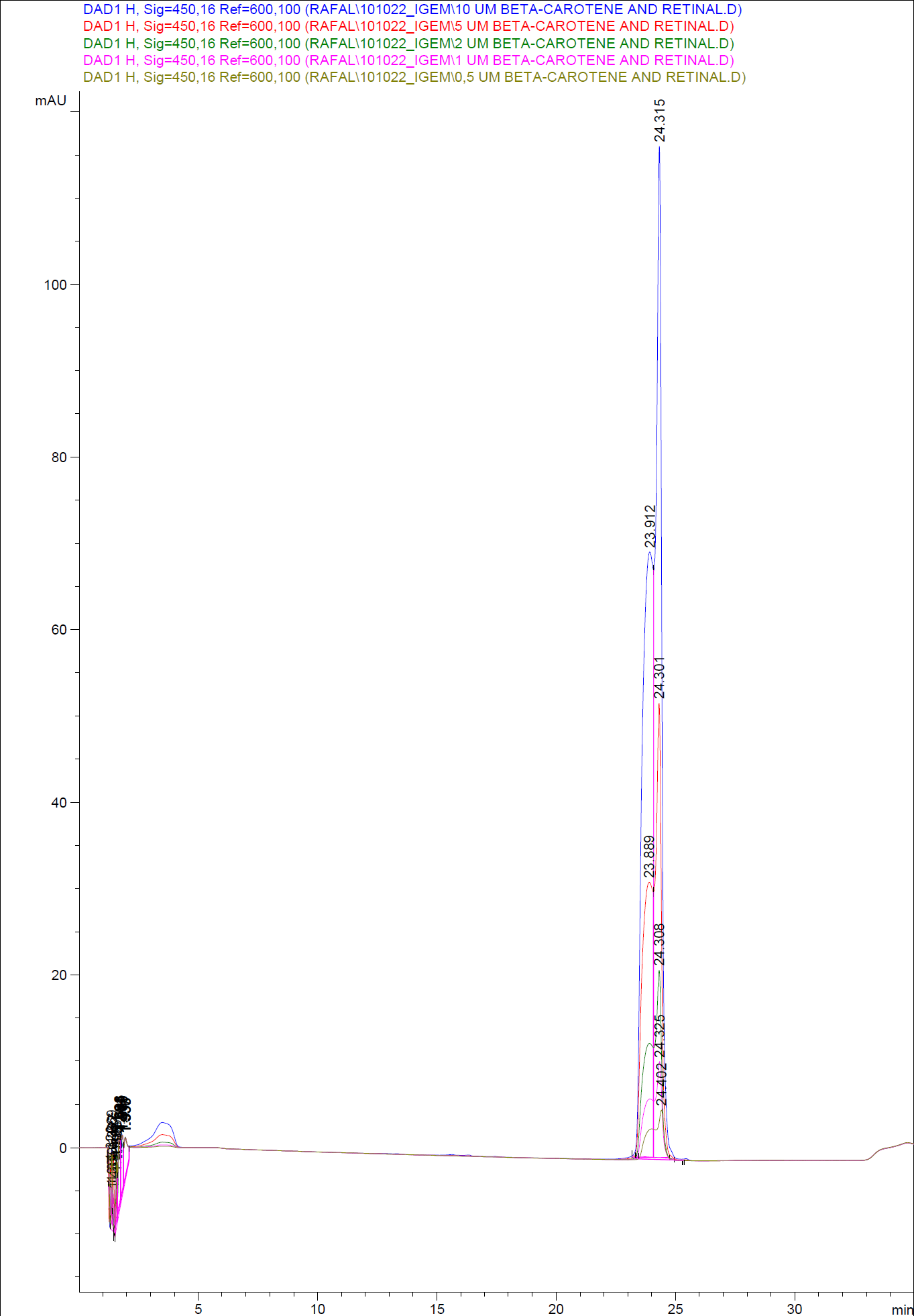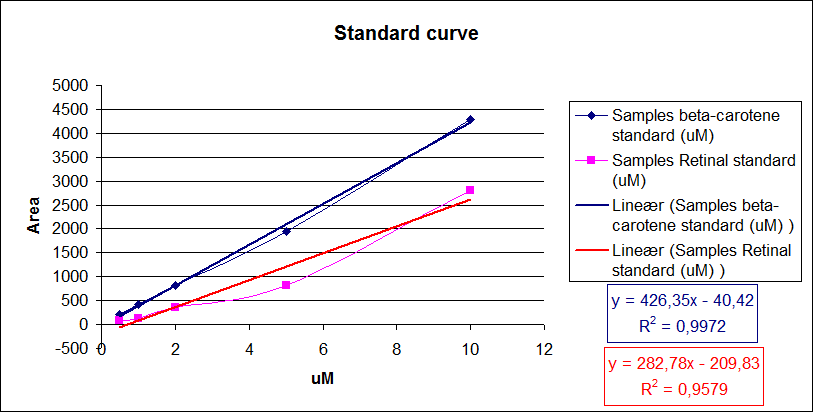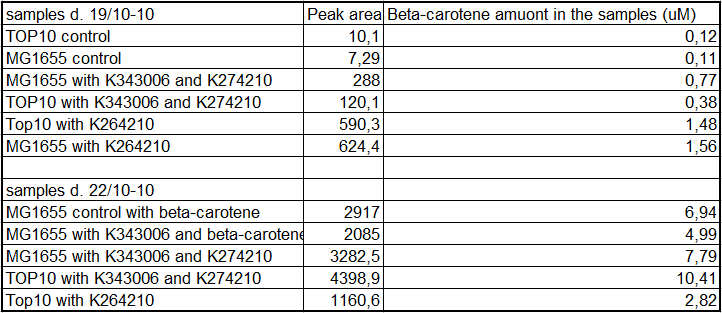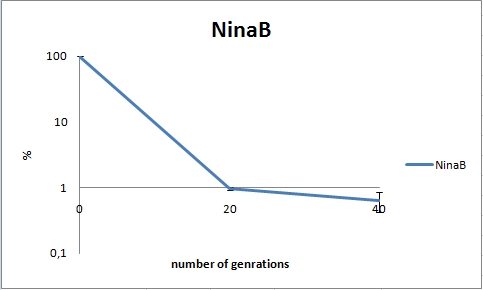Team:SDU-Denmark/K343006
From 2010.igem.org
(Difference between revisions)
(→K343005) |
|||
| Line 3: | Line 3: | ||
<div id="subnavi"> | <div id="subnavi"> | ||
<div id="parts"> | <div id="parts"> | ||
| + | __TOC__ | ||
== K343005 == | == K343005 == | ||
===UV-Vis determination of beta-carotene and retinal production=== | ===UV-Vis determination of beta-carotene and retinal production=== | ||
| Line 29: | Line 30: | ||
All data can be seen under [https://static.igem.org/mediawiki/2010/7/7d/Team-SDU-Denmark-UV-Vis_determination_of_Carotenoids_and_polyene_chromophores_.zip Raw data] | All data can be seen under [https://static.igem.org/mediawiki/2010/7/7d/Team-SDU-Denmark-UV-Vis_determination_of_Carotenoids_and_polyene_chromophores_.zip Raw data] | ||
| + | |||
| + | ==K343006== | ||
| + | === HPLC determination of beta-carotene and retinal production === | ||
| + | Apart from spectrophotometry, the resuspension of beta-carotene or retinal in acetone can be subjected to analysis by HPLC. HPLC can be used to separate retinal from beta-carotene, to get a better indication of whether or not our retinal-generating part actually produces retinal from beta-carotene.<br> | ||
| + | In this experiment cells were prepared and harvested according to protocol [https://2010.igem.org/Team:SDU-Denmark/protocols#EX1.1 EX1.1]. This experiment was performed with six different strains of ''E. coli'':<br> <br> | ||
| + | Wild type TOP10<br> | ||
| + | Wild type MG1655<br> | ||
| + | TOP10/pSB1A2-K274210 <br> | ||
| + | MG1655/pSB1A2-K274210<br> | ||
| + | TOP10/pSB1A2-K274210/pSB1C3-K343005<br> | ||
| + | MG1655/pSB1A2-K274210/pSB1C3-K343005<br> | ||
| + | Both K343005 and K274210 were constitutively expressed.<br><br> | ||
| + | MG1655 containing PSB1A2 with K274210 plus PSB1C3 with K343005 both under a constitutively active promotor<br> | ||
| + | The measurements were preformed on cells after 20 hours of growth. The resulting graphs is presented beneath the text.<br> | ||
| + | [[Image:Team SDU-Denmark-HPLC samples2.png|thumb|left|300px|HPLC analysis of samples from the 19th oct. 2010 Beta-carotene Peaks are clearly present, but no retinal peaks are observed. Measurements were made after 20 hours of growth]] | ||
| + | [[Image:Team SDU-Denmark-HPLC samples1.png|thumb|center|300px|HPLC analysis of samples from the 22nd oct. 2010 Beta-carotene Peaks are clearly pressent, but no retinal peaks are observed. Measurements were made after 20 hours of growth]]<br> | ||
| + | When looking at the retinal and beta-carotene standards analysed on the HPLC, peaks for both chemical are clearly present. The retinal retention time is 3,480-3,490 minutes and the beta-carotene retention time is 23,300-23,600 minutes.<br> | ||
| + | The spectres for the first run of samples show large amounts of beta-carotene, smaller amounts of which also are products produced by the K274210 biobrick or absorbed form the media in the cells where the K274210 biobrick is absent.<br> | ||
| + | The spectre shows no measurable amounts of retinal in neither of the samples, but the samples produced by bacteria containing the K343006 brick have a lower amount of beta-carotene.<br> which can indicated that either the bacteria’s production of beta-carotene is lowered or that some of the beta-carotene have been metabolized in the cell, either to a non-measurable concentration of Retinal or some other metabolite. It is also a possibility that the retinal is exported out of the cells.<br> | ||
| + | In the spectres from the second run of samples again show large amounts of beta-carotene produced by the K274210 biobrick or absorbed form the media in the cells where the K274210 biobrick is absent.<br> | ||
| + | The only sample displaying any changes form the first run on the HPLC is TOP10 containing both the K343006 and K274210 biobricks. In the spectre higher amounts of cell metabolites some of them still being produced by the K274210 biobrick but also others produced by the cell. | ||
| + | In this spectra the peak with a retention time of 3,969 is close to the retention time of retinal form the standards but when examining the spectre of the peak it can be concluded that it not a retinal peak.<br> | ||
| + | <br> | ||
| + | In order to assess and quantify the results a standard dilution of beta-carotene and retinal was made and measured: 10 µM, 5 µM, 1 µM, 2 µM, 0,5 µM. The standard dilutions were also measured on the HPLC with the same injection volumen and program as the samples. The resulting graphs are presented beneath <br> | ||
| + | [[Image:Team SDU-Denmark-HPLC standards1.png|400px|thumb|center| HPLC of standard dilutions of beta-carotene and retinal]] | ||
| + | <br> | ||
| + | When doing a HPLC analysis it is possible to quantify the amounts of the chemical compounds in the samples.<br> | ||
| + | This is done by doing a standard curve with known solutions of the chemical and recording the area under the peaks. The peak area correspond to the concentration of the chemical in the sample.<br> | ||
| + | Then plotting the area under the peaks on the y- axis, the know concentrations of the standards on the x-axis and calculating the regression line.<br> | ||
| + | Now it is possible to calculate unknown concentrations from samples using the regression line from the standard curves.<br> | ||
| + | The results for our HPLC analysis can be seen beneath the text.<br> | ||
| + | [[Image:Team-SDU-Denmark-Amount of beta-carotene and retinal i standards.png|thumb|400px|center|Standard curve of area under the HPLC peaks against beta-carotene and retinal concentration. Regression lines were made.]] | ||
| + | From the equations for the regression line it is possible to calculate the amount of beta-carotene produced by bacteria grown for 20 hours in LB media.<br> | ||
| + | [[Image:Team-SDU-Denmark-Beta-carotene amounts.png|400px|thumb|center|Tabel showing calculatet beta-carotene content in samples]] | ||
| + | <br> | ||
| + | All data can be seen under [https://2010.igem.org/Image:Team-SDU-denmark-HPLC_determination_af_beta-carotene_and_retinal_production.zip Raw data]<br> | ||
| + | |||
| + | === Stability assay === | ||
| + | To dertermine the stability of our pSB1C3-K343006 plasmid, a stability experiment was carried out according to protocol[[https://2010.igem.org/Team:SDU-Denmark/protocols#Stability_assay SA1.1]]. ''E.coli'' MG1655/pSB1C3-K343006 was grown in LB media without chloramphenicol, whereby no selection pressure is excerted on the bacteria. Dilutions of the culture was spreaded on LA plates and LA plates with 35ug/mL chloramphenicol, respectively, and the colony forming units (cfu) was determined for each plate. The cfu for the LA plates represents the total amount of bacteria in the culture, and the cfu of LA plates with chloraphenicol corresponds to the amount of plasmid carrying bacteria. The percentage of the total amount of bacteria carrying the plasmid was plotted in a semi-logarithmic graph as a function of number of generations.<br><br> | ||
| + | [[Image:Team-SDU- NinaB stab2.png|400px|thumb|center|Stability assay of ''E. coli'' strain MG1655-pSB1C3-K343006 showing that almost all cells have shed their plasmids within 20 generations, however some cells kept the plasmids for up to 40 generations.All data can be seen under [https://static.igem.org/mediawiki/2010/3/39/Team-SDU-_NinaB_stability_assay.ZIP Raw data]]]<br><br> | ||
| + | |||
| + | As seen in the graph, almost all of the bacteria had shedded the plasmid after 20 generations, suggesting that the plasmid is only stable within the cell for a few generations (<20). This is presumably due to the strain brought upon the bacteria by the plasmid. Thereby when the bacteria are carrying a high-copy plasmid like pSB1C3-K343006 it is plausible that the bacteria will quickly shed the plasmid when no longer exposed to a selection pressure. | ||
| + | |||
| + | ===Growth assay=== | ||
| + | The purpose of this assay is to see if our transformants deviate from the wild type in growth rate. In the growth measurement assay we have measured OD at 550 nm every hour for 12 hours and at hour 24. In the experimental setup we used no lag phase was observed in any of the measurements. | ||
| + | The graph below shows the growth of our wild type E. coli strain MG1655, the MG1655/pSB1C3-K343006 respectively.<br><br> | ||
| + | [[Image: Team SDU-Denmark OD WT+NinaB.JPG|400px|OD of WT + NinaB|thumb|center|Growth curve showing measured OD at 550nm. Samples were taken every hour over a 12 hour perion + one sample after 24 hours. In graph ''E. coli'' strain MG1655-pSB1C3-k343006 is compaired with Wild type ''E. coli'' strain MG1655 showing no significant difference between the three graphs. No Lag phase is seen.All data can be seen under [https://static.igem.org/mediawiki/2010/6/68/Team_SDU-Denmark_Growth_rate_assay_no._2_NinaB.zip Raw data]]] <br><br> | ||
| + | From our data we see no significant difference between the plasmid carrying bacteria and the wild type. This can be said to be quite conteradictory to our results obtained from the stability assay. The transitory stability of pSB1C3-K343006 suggests that it is highly unfavorable for the bacteria, wherefore it might be expected that the growth of the bacteria containg this plasmid would be affected. Thus, however much a disadvantage the plasmid pose to the bacteria, their growth are not significantly influenced by the plasmid. The added reproduction load due to the plasmids, might also prolong the lag phase of the bacteria. Whether this is the case can not be concluded based on this experiment as no lag phase was observed in this experiment. | ||
| + | |||
<br> | <br> | ||
<br> | <br> | ||
</div></div> | </div></div> | ||
Revision as of 23:05, 27 October 2010
 "
"
